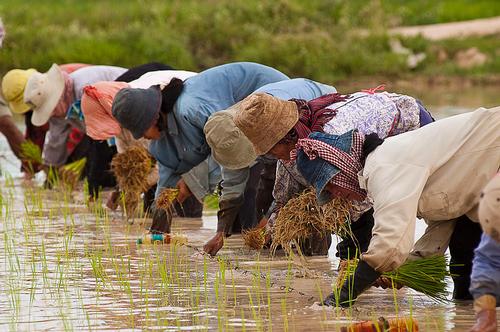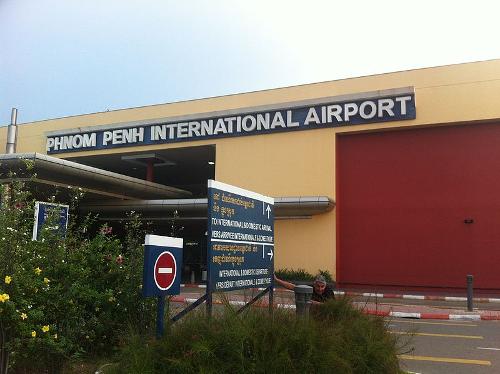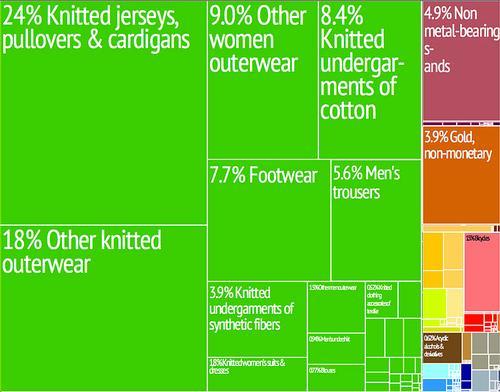CAMBODIA
Economy

Economy
Cities in CAMBODIA
| Phnom-penh |
Economy
General
Cambodia ExportPhoto: R Haussmann, Cesar Hidalgo, et. al. CC 3.0 no changes made
The Khmer Rouge period was devastating for the Cambodian economy. Everything that had been built up with difficulty before that time was finally demolished at once. It was not until 1979 that reconstruction could start again, but there was a lack of skilled personnel to make a good start. Roads and bridges were also destroyed and the land was littered with mines. After the withdrawal of the Vietnamese and the collapse of the Soviet Union in 1989, the economy took further blows.
It wasn't until the mid-1990s that some light came into the economic darkness. After the Khmer Rouge ending the Guerrilla, the investment climate improved and entrepreneurs from Thailand, Singapore and Malaysia turned to Cambodia. The economic crisis in Asia in the late 1990s caused a brief setback, but from that time onwards there has been decent economic growth and unemployment has fallen sharply. As a kind of reward for good policy, Cambodia was allowed to join ASEAN in 1999.
Cambodia is currently still highly dependent on international organizations and governments. Also important will be whether widespread corruption can be reduced and current political stability maintained.
25.3% of the gross national product (GNP) comes from agriculture, 32.8% from industry, and the tertiary sector contributes 41.9% to this. (2017)
The capital Phnom Penh is an important river port and of course the commercial center of Cambodia.
Agriculture, forestry and fishing
 Cambodia Rice plantingPhoto: Brad Collis CC 2.0 Generic no changes made
Cambodia Rice plantingPhoto: Brad Collis CC 2.0 Generic no changes made
Approximately 50% of the total working population works in agriculture, although only 20% of the land is suitable for agricultural purposes and only 4% is used effectively. In the nineties rice had to be imported, but from 1999 people could feed their own population and even export of rice took place. The state buys the rice at a price below cost, so that much is traded on the private market. In addition to rice, corn, beans, cassava, bananas and tobacco are grown.
The main agricultural areas are located on the Mekong and the Tonlé Sap. Agriculture is completely privatized and most farmers still work the land in a traditional way.
Forest products are largely exported through concessions to Malaysia and Indonesia. Rubber production has a large share in exports.
Fishing plays a major role in the food supply of the population. Due to deforestation, fishing is suffering from the salinization of lakes and rivers. Lake Tonlé Sap is one of the richest fishing grounds in the world. The woodlands along the banks, which are flooded in the rainy season, are particularly nutrient rich and are an ideal spawning area for fish. With a yield of approximately ten tons per km2, the lake accounts for three-quarters of the domestic fishery and provides the Cambodian population with almost half of their animal protein. The fishermen lease the fishing grounds from entrepreneurs who have government concessions. In 1997, Lake Tonlé Sap was designated a protected biosphere because of its unique ecosystem.
Mining and industry
Mining and industry are becoming increasingly important. These sectors have a share of approximately 33% of the national income and 20% of the working population works in them.
The industrial activities are mainly limited to the production of cigarettes, rubber footwear and cement. The government stimulates the food processing and clothing industry. The manufacturing of clothing is the fastest growing industry due to the presence of a very cheap labor force and represented 80% of Cambodia's exports in 2013 and the export value grew from USD 3.4 billion in 2012 to 5 billion in 2017. Most textile products go to Europe and the United States. Most trade is through private channels, especially to Thailand. The main exports are rubber, tobacco, timber and soybeans. Consumer goods often enter the country through smuggling.
Cambodia does not have many minerals; phosphate and gemstones are the most important; copper, tin, iron ore and bauxite are not yet exploitable. Off the coast there are promising oil and gas fields.
Traffic
 Cambodia Phnom Penh International AirportPhoto: Graham Maclachlan CC 3.0 Unported no changes
Cambodia Phnom Penh International AirportPhoto: Graham Maclachlan CC 3.0 Unported no changes
In the period 1970-1978, the infrastructure was largely destroyed by the battle between the government army and the Khmer Rouge. In 2000, the road network was 12,300 km long, of which only 2000 km was paved. Due to sabotage by guerrillas, the road network is in a very bad condition, but they are working hard to improve it. If this succeeds, Cambodia could form an important link between Thailand and Vietnam.
Kompong Som is the international port on the Gulf of Thailand. There is an international airport at Phnom Penh.
There is a railway network of approximately 600 kilometers that connects the main cities. There are no more than two lines; the northwestern line runs from Phnom Penh via Pursat and Battambang to Sisophon. The southern line connects Phnom Penh to Sihanoukville via Takeo, Kampot and Kep. Cambodian trains run slowly and are uncomfortable.
The bamboo train is special, one of the strangest means of transport in the world. They are only two axes with a bamboo floor on top. A diesel engine serves as a power source.
Sources
Canesso, C. / Cambodia
Chelsea House Publishers
Colet, J. / Cambodia handbook
Footprint Handbooks
Green, R. / Cambodia
Lucent Books
Kleinen, J. / Cambodja
Koninklijk Instituut voor de Tropen ; Novib
Peterse, L. / Cambodja
Gottmer/Becht,
Wulf, A. / Cambodja, Laos
Het Spectrum
CIA - World Factbook
BBC - Country Profiles
Copyright: Team The World of Info
